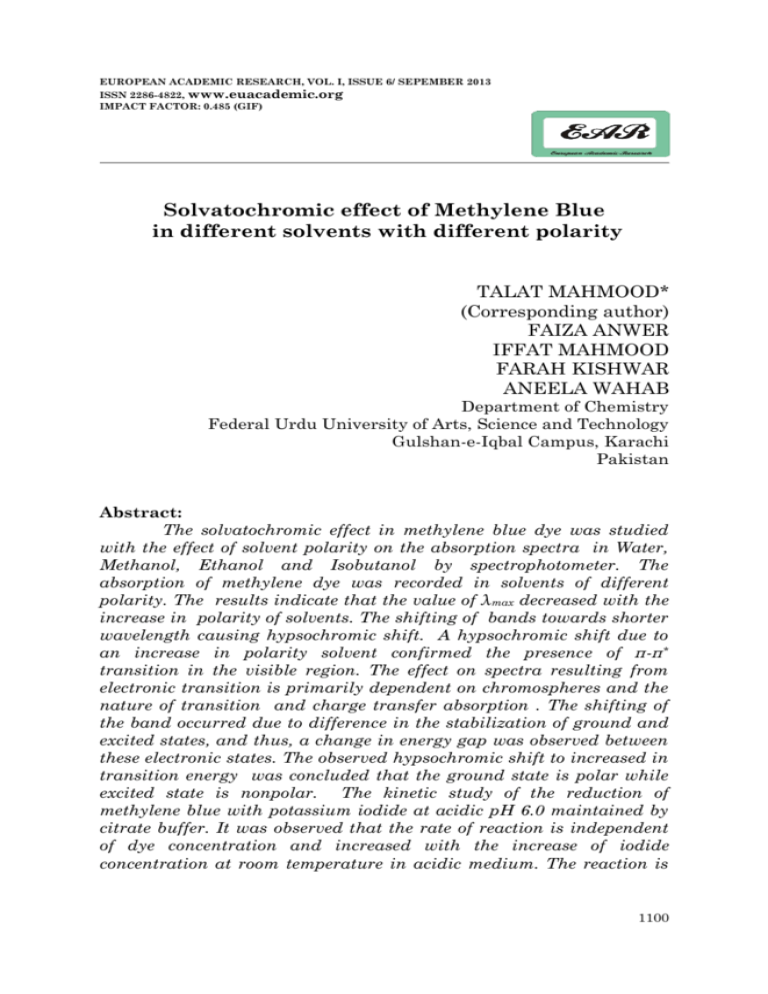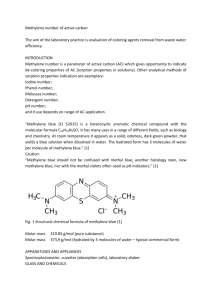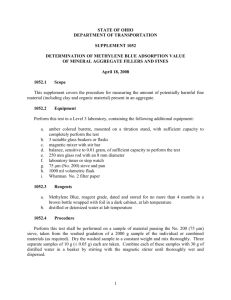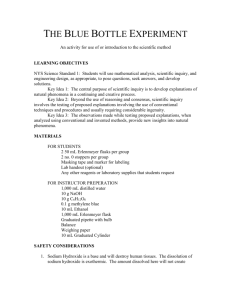Solvatochromic effect of Methylene Blue in different solvents with
advertisement

EUROPEAN ACADEMIC RESEARCH, VOL. I, ISSUE 6/ SEPEMBER 2013 ISSN 2286-4822, www.euacademic.org IMPACT FACTOR: 0.485 (GIF) Solvatochromic effect of Methylene Blue in different solvents with different polarity TALAT MAHMOOD* (Corresponding author) FAIZA ANWER IFFAT MAHMOOD FARAH KISHWAR ANEELA WAHAB Department of Chemistry Federal Urdu University of Arts, Science and Technology Gulshan-e-Iqbal Campus, Karachi Pakistan Abstract: The solvatochromic effect in methylene blue dye was studied with the effect of solvent polarity on the absorption spectra in Water, Methanol, Ethanol and Isobutanol by spectrophotometer. The absorption of methylene dye was recorded in solvents of different polarity. The results indicate that the value of λmax decreased with the increase in polarity of solvents. The shifting of bands towards shorter wavelength causing hypsochromic shift. A hypsochromic shift due to an increase in polarity solvent confirmed the presence of π-π* transition in the visible region. The effect on spectra resulting from electronic transition is primarily dependent on chromospheres and the nature of transition and charge transfer absorption . The shifting of the band occurred due to difference in the stabilization of ground and excited states, and thus, a change in energy gap was observed between these electronic states. The observed hypsochromic shift to increased in transition energy was concluded that the ground state is polar while excited state is nonpolar. The kinetic study of the reduction of methylene blue with potassium iodide at acidic pH 6.0 maintained by citrate buffer. It was observed that the rate of reaction is independent of dye concentration and increased with the increase of iodide concentration at room temperature in acidic medium. The reaction is 1100 Talat Mahmood, Faiza Anwer, Iffat Mahmood, Farah Kishwar, Aneela Wahab – Solvatochromic effect of Methylene Blue in different solvents with different polarity found to be first order with respect to iodide and zero order with respect to methylene blue concentration. Key words: Metylene blue, solvatochromic effect, hypsochromic shift, solvent polarity. Introduction Dyes are synthetic aromatic water soluble dispersible organic colorants,having potential application in various industries.The effect of different solvents on the dyes spectra and fading of reduction of dyes was investigated.(1-5) The effect of solvent on λmax shift able us to distinguish the types of electronic transition.(6-9). Adsorption isotherm of the Methylene blue (MB) on the activated carbon was determined and correlated with common isotherm equations [10]. Methylene blue is organic polar dye. It is soluble in water. Methylene blue shows absorbance in visible region due to involving of π-π* and n-π* transitions present in molecules. Methylene blue was prepared in Water then analyzed absorbance with the help of spectrophotometer. Solutions showed maximum absorbance in water at 668 nm. Solution of Methylene blue in different solvent methanol, Ethanol, Iso butanol analyzed with the help of spectrophotometer. Methylene blue in methanol showed maximum absorbance at 654 nm. Methylene blue in ethanol showed maximum absorbance at 653nm. Methylene blue in Iso butanol showed maximum absorbance also at 655 nm. Present work is based to investigate the solvatochromic effect and kinetics of methylene blue by spectrophotometer. The kinetics of the reduction of methylene blue in acidic medium were investigated as a function of concentration of dye, concentration of KI at constant pH. The reaction kinetics data EUROPEAN ACADEMIC RESEARCH, VOL. I, ISSUE 6/ SEPTEMBER 2013 1101 Talat Mahmood, Faiza Anwer, Iffat Mahmood, Farah Kishwar, Aneela Wahab – Solvatochromic effect of Methylene Blue in different solvents with different polarity were used to calculate the order of reaction with respect to the concentration of the dye and concentration of reductant. Material and Method All the reagents used were of analytical grade, purchased from Merck. All glassware used to be of standard quality. They were properly cleaned and rinsed with distilleddeionized water. The UV-2600 double beam spectrophotometer was used to measure the absorbance by using quartz cells. Jenway, Model 3510 pH meter was used for pH measurement. Procedure A stock solution of dye was prepared and it is diluted by using distilled water. The pH of the solution was maintained by using a buffer system of Citric acid and sodium citrate. A reaction mixture was prepared by taking a known volume of methylene blue and potassium iodide and buffer solution to maintain the pH of the solution. The absorbance data was recorded for one hour and the same procedure was adopted to measure absorbance as a function of absolute solvents of different polarities. The absorbance data was collected at 668 nm as a function of dye concentration and reductant to study the kinetics of the reaction. Result and Discussion The absorption spectra of methylene blue having concentration 7 ×10-5M was recorded in water, absolute methanol, ethanol, and isobutanol using Spectrophotometer. The values of λmax showed slightly increased with the decrease of polarity. The data are tabulated in Table 1 and spectra are given in Fig.1-4.The result indicates that the λmax highly EUROPEAN ACADEMIC RESEARCH, VOL. I, ISSUE 6/ SEPTEMBER 2013 1102 Talat Mahmood, Faiza Anwer, Iffat Mahmood, Farah Kishwar, Aneela Wahab – Solvatochromic effect of Methylene Blue in different solvents with different polarity depended upon solvent polarity. It was observed that wavelength shifts towards shorter wavelengths as the solvent was changed from polar (water) to nonpolar (methanol, ethanol and isobutanol). The shifting of wavelength showed hypsochromic shift. The shifting of the band occurred due to difference in the stabilization of ground and excited states and thus causes a change in energy gap between these electronic states. The molar absorptivity coefficient (Є) for methylene blue in different solvents evaluated show the trend that the molar absorptivity coefficient increased as the polarity of the solvent was lowered. The decrease of molar absorptivity (Є) with increasing polarity shows that as the energy gap between two states (ground and excited state) increasing, possibility of transition becomes less, hence decreases molar absorptivity coefficient (Є), which is also shown by the values of transition energy (ET). Transition energy is calculated from the following relation (218). ET = hcNA λ Where transition energy is ET, Planck’s constant is h, the speed of light is c and Avogadro’s number is NA. The value of the transition energy with the increase of solvent polarity as in the water show the ground state was more polar than the excited state. The energy difference between ground state and excited state become greater corresponding to hypsochromic effect on the spectrum by increasing the polarity of the solvent. Wavelength (λmax), Absorbance (A), Molar Absorptivity (Є) and Transition energy (ET) of Methylene blue In different solvent EUROPEAN ACADEMIC RESEARCH, VOL. I, ISSUE 6/ SEPTEMBER 2013 1103 Talat Mahmood, Faiza Anwer, Iffat Mahmood, Farah Kishwar, Aneela Wahab – Solvatochromic effect of Methylene Blue in different solvents with different polarity S.NO Solvents Maximum wavelength λmax (nm) Absorbance 1 2 3 4 Water Methanol Ethanol Isobutanol 667 676 678 685 0.693 0.864 1.256 0.345 Molar Absorptivity Lmol-1. cm1 56621 65,237 106,254 22,409 Transition energy (ET) 17.95 17.71 17.66 17.48 Table 1 Absorbance of Methylene blue in Absolute solvent Concentration of Methylene blue =7x10-5 Concentration of Methylene blue =7x10-5 Solvent = Water Solvent = 10% Methanol Fig 1.1 Concentration of Methylene blue = 7x10-5 Solvent = Ethanol Fig1.2 Concentration of Metylene blue = 7x10-5 Solvent = 10% Iso butanol Fig1.3 Fig 1.4 EUROPEAN ACADEMIC RESEARCH, VOL. I, ISSUE 6/ SEPTEMBER 2013 1104 Talat Mahmood, Faiza Anwer, Iffat Mahmood, Farah Kishwar, Aneela Wahab – Solvatochromic effect of Methylene Blue in different solvents with different polarity Kinetics of Reduction of Methylene blue with KI The present work also involves kinetics of the reduction of the dye in acidic medium at 665nm wavelength in visible range. The influence of dye concentration ranging from 5x105,6x10-5,8x10-5 was observed at a constant concentration of 0.1M KI and 6 pH by spectrophotometric method. The values for rate constant were determined by the linear plot of ln (AaAt) vs Time. The results are tabulated in figure 2.1-2.3. It was also found that there is no significant change in rate constant with the change in methylene blue concentration, which show that the rate of reaction is not affected by the concentration of dye. It is concluded that reaction is zero order with respect to dye concentration. Effect of concentration of Methylene blue Concentration of Methylene blue = 5x10-5M, KI=0.1M , pH = 6.0 Fig. 2.1 EUROPEAN ACADEMIC RESEARCH, VOL. I, ISSUE 6/ SEPTEMBER 2013 1105 Talat Mahmood, Faiza Anwer, Iffat Mahmood, Farah Kishwar, Aneela Wahab – Solvatochromic effect of Methylene Blue in different solvents with different polarity Concentration of Methylene blue = 6x10-5M, KI=0.1M , pH = 6.0 Fig. 2.2 Concentration of Methylene blue = 8x10-5M, KI=0.1M , pH = 6 Fig. 2.3 The effect of concentration of potassium iodide ranging from (0.1, 0.4, 0.5 mol.dm-3) was studied Fig.3.1-3.3. The results show that the rate constant increase with the increase in the potassium iodide concentration at hydrogen ion activity 6.0. The increase in concentration of iodide results an increase in the collision of molecules leads to the formation of activated complex,which in turn is converted into the reduced form of the dye. The absorbance data showed a gradual decrease with the increase of concentration of potassium iodide. The decrease absorbance was due to the reduction of methylene blue with EUROPEAN ACADEMIC RESEARCH, VOL. I, ISSUE 6/ SEPTEMBER 2013 1106 Talat Mahmood, Faiza Anwer, Iffat Mahmood, Farah Kishwar, Aneela Wahab – Solvatochromic effect of Methylene Blue in different solvents with different polarity iodide.The linear plot of ln(Aa – At) versus time showed the first order dependence of iodide. Effect of concentration of KI Concentration of Methylene blue = 7x10-5M, Concentration of KI = 0.1 M , pH = 6.0 Fig. 3.1 Concentration of Methylene blue = 7x10-5M, Concentration of KI = 0.4 M , pH = 6.0 Fig.3.2 EUROPEAN ACADEMIC RESEARCH, VOL. I, ISSUE 6/ SEPTEMBER 2013 1107 Talat Mahmood, Faiza Anwer, Iffat Mahmood, Farah Kishwar, Aneela Wahab – Solvatochromic effect of Methylene Blue in different solvents with different polarity Concentration of Methylene blue = 7x10-5M, Concentration of KI = 0.5 M , pH = 6.0 Fig. 3.3 Conclusion The study of solvatochromic effect of Methylene blue with iodide in aqueous and aqueous alcoholic mixture in acidic medium was studied. The experimental data obtained as a function of methylene blue concentration, potassium iodide concentration and kinetic study of the reaction let to the following conclusion. The solvatochromic effect was studied by spectrophotometric analysis and from the spectral analysis of methylene blue in aqueous and absolute solvents it was observed that λmax shifts towards longer wavelength as the solvent was changed from polar(water) to nonpolar (methanol,ethanol and isobutanol). The shifting of wavelength showed a bathochromic shift with decreased in transition energy and it was concluded that the ground state is polar while the excited state of methylene is nonpolar. The kinetic study of the reduction of methylene blue with potassium iodide led to the conclusion that the reaction follows zero order with respect to methylene blue and first order to iodide in acidic medium. Methylene blue is a member of thiazine dye the reduction of dye molecule involves breaking EUROPEAN ACADEMIC RESEARCH, VOL. I, ISSUE 6/ SEPTEMBER 2013 1108 Talat Mahmood, Faiza Anwer, Iffat Mahmood, Farah Kishwar, Aneela Wahab – Solvatochromic effect of Methylene Blue in different solvents with different polarity of double bond in the presence of inorganic reductant. In the reduced form of dye, the double bond on the central carbon atom shifts to the nitrogen of NH2+.The carbon becomes electron deficient and requires reducing agent to provide electrons. The iodide attacks at the carbon atom providing electron and disturb the π system of dye. BIBLIOGRAPHY: Azmat, R, Qamar, N., Saeed, A., Uddin, F. 2008. Chin. J. CHEM. 26: 631. Bamabas,M.V.,Liu,A.,Trifunac,A.D.,Kronga,V.,V.,Chang ,C.T. 1992. J.Phts.Chem.96: 212 Bevilaque,T.,Goncalves,T.F.,Venturine,C.D.G.,Machado, V.G. 2006. Spectrochim. Acta, Part A 6:535. Chang,T.L., Chang. 1992. H.C.J.Phys.Chem. 96:4874. Hameed, B.H., Din, A.T.M., Ahmad, A.L. 2007. Journal of Hazardous Material 141(3): 457-856. Saeed, R., Fahimuddin, Khalid, Z., Turk, J. 2004. Chem. 28: 351. Saeed, R., Fahimuddin. 2006. Int. J. Pure Appl. Chem. 1:65. Sato, T., Buchner, R. 2004. J.Phys.Chem. 108: 5007. Taneja, A., Paliwala, M., Kumara, A., Singh, S., Ameta, S. C., Ameta, R. 2009. Arabian J. Sci. Eng., Sect. A 34: 37. Yamamoto,S., Kobashi,S., Tsutsui,K., Sueishi. 2007. Spectrochim. Acta, PartA 66:302. EUROPEAN ACADEMIC RESEARCH, VOL. I, ISSUE 6/ SEPTEMBER 2013 1109



